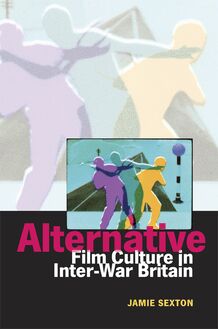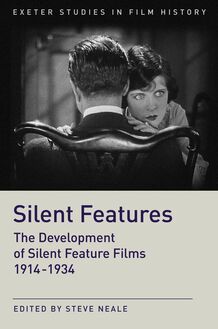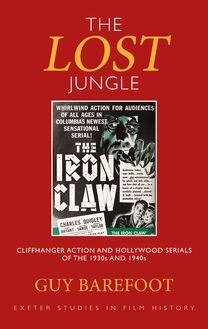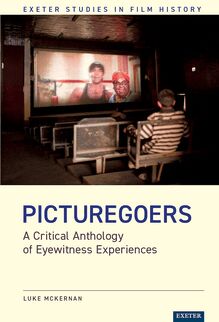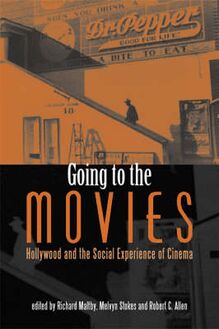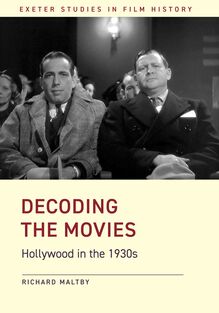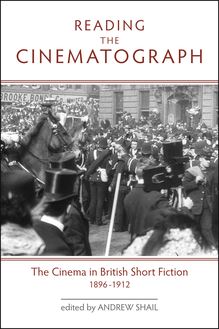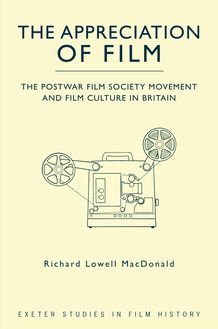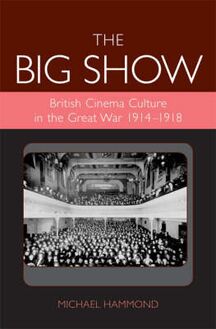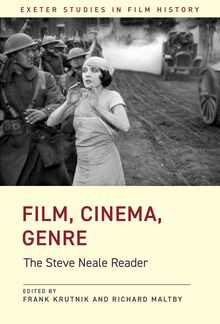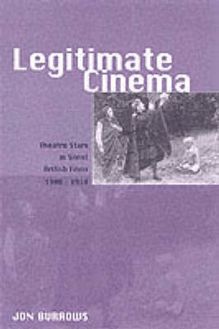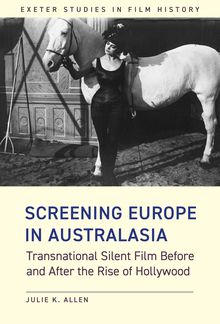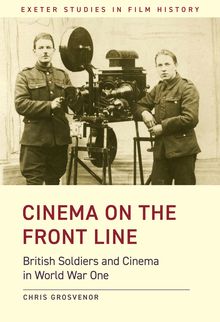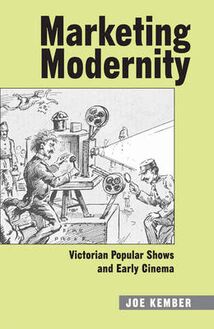Charles Urban , livre ebook
163
pages
English
Ebooks
2015
Vous pourrez modifier la taille du texte de cet ouvrage
Obtenez un accès à la bibliothèque pour le consulter en ligne En savoir plus
Découvre YouScribe et accède à tout notre catalogue !
Découvre YouScribe et accède à tout notre catalogue !
163
pages
English
Ebooks
2015
Vous pourrez modifier la taille du texte de cet ouvrage
Obtenez un accès à la bibliothèque pour le consulter en ligne En savoir plus
Publié par
Date de parution
31 juillet 2015
Nombre de lectures
4
EAN13
9780859899857
Langue
English
Poids de l'ouvrage
1 Mo
Charles Urban was a renowned figure in his time, and he has remained a name in film history chiefly for his development of Kinemacolor, the world’s first successful natural colour moving picture system. He was also a pioneer in the filming of war, science, travel, actuality and news, a fervent advocate of the value of film as an educative force, and a controversial but important innovator of film propaganda in wartime.
The book uses Urban’s story as a means of showing how the non-fiction film developed in the period 1897-1925, and the dilemmas that it faced within a cinema culture in which the entertainment fiction film was dominant. Urban’s solutions – some successful, some less so – illustrate the groundwork that led to the development of documentary film. The book considers the roles of film as informer, educator and generator of propaganda, and the social and aesthetic function of colour in the years when cinema was still working out what it was capable of and how best to reach audiences.
Luke McKernan also curates a web resource on Charles Urban at www.charlesurban.com
List of Illustrations
Acknowledgements
Note
Introduction
1. ‘That Slick Salesman in the Silk Hat’
2. We Put the World Before You
3. The Eighth Wonder of the World
4. The Motion Picture Object Lesson for America
5. The Living Book of Knowledge
Conclusion
Notes
Select Bibliography
Index
Publié par
Date de parution
31 juillet 2015
EAN13
9780859899857
Langue
English
Poids de l'ouvrage
1 Mo
C HARLES U RBAN
Based on original research in Charles Urban’s own papers, this is the first biography of this influential film-maker and innovator. It is also a historical study of the development of the non-fiction film in Britain and America in the early years of cinema, told through the experiences of the leading pioneer of the form.
Charles Urban was a renowned figure in his time, and he has remained a name in film history chiefly for his development of Kinemacolor, the world’s first successful natural colour moving picture system. He was also a pioneer in the filming of war, science, travel, actuality and news, a fervent advocate of the value of film as an educative force, and a controversial but important innovator of film propaganda in wartime.
The book uses Urban’s story as a means of showing how the non-fiction film developed in the period 1897-1925, and the dilemmas that it faced within a cinema culture in which the entertainment fiction film was dominant. Urban’s solutions—some successful, some less so—illustrate the groundwork that led to the development of documentary film. The book considers the roles of film as informer, educator and generator of propaganda, and the social and aesthetic function of colour in the years when cinema was still working out what it was capable of and how best to reach audiences.
Luke McKernan is a film historian and Lead Curator of Moving Image at the British Library. He has written widely on early film, and also curates a web resource on Charles Urban.
COVER IMAGE : Charles Urban with camera team at Delhi (see figure 16 for details)
Exeter Studies in Film History
Published by University of Exeter Press in association with the Bill Douglas Centre for the History of Cinema and Popular Culture
Series Editors: Richard Maltby, Professor of Screen Studies, Flinders University, South Australia and Steve Neale, Professor of Film Studies and Academic Director of the Bill Douglas Centre, University of Exeter.
Parallel Tracks: The Railroad and Silent Cinema
Lynne Kirby (1997)
The World According to Hollywood, 1918-1939
Ruth Vasey (1997)
‘Film Europe’ and ‘Film America’: Cinema, Commerce and
Cultural Exchange 1920-1939
edited by Andrew Higson and Richard Maltby (1999)
A Paul Rotha Reader
edited by Duncan Petrie and Robert Kruger (1999)
A Chorus of Raspberries: British Film Comedy 1929-1939
David Sutton (2000)
The Great Art of Light and Shadow: Archaeology of the Cinema
Laurent Mannoni, translated by Richard Crangle (2000)
Popular Filmgoing in 1930s Britain: A Choice of Pleasures
John Sedgwick (2000)
Alternative Empires: European Modernist Cinemas and Cultures of Imperialism
Martin Stollery (2000)
Hollywood, Westerns and the 1930s: The Lost Trail
Peter Stanfield (2001)
Young and Innocent? The Cinema in Britain 1896-1930
edited by Andrew Higson (2002)
Legitimate Cinema: Theatre Stars in Silent British Films 1908-1918
Jon Burrows (2003)
The Big Show: British Cinema Culture in the Great War (1914 -1918)
Michael Hammond (2006)
Multimedia Histories: From the Magic Lantern to the Internet
edited by James Lyons and John Plunkett (2007)
Going to the Movies: Hollywood and the Social Experience of Cinema
edited by Richard Maltby, Melvyn Stokes and Robert C. Allen (2007)
Alternative Film Culture in Inter-War Britain
Jamie Sexton (2008)
Marketing Modernity: Victorian Popular Shows and Early Cinema
Joe Kember (2009)
British Cinema and Middlebrow Culture in the Interwar Years
Lawrence Napper (2009)
Reading the Cinematograph: The Cinema in British Short Fiction 1896-1912
edited by Andrew Shail (2010)
UEP also publishes the celebrated five-volume series looking at the early years of English cinema, The Beginnings of the Cinema in England , by John Barnes.
Charles Urban
Pioneering the Non-fiction Film in Britain and America, 1897-1925
Luke McKernan
UNIVERSITY of EXETER PRESS
For Jacob
First published in 2013 by University of Exeter Press Reed Hall, Streatham Drive Exeter, Devon, EX4 4QR
www.exeterpress.co.uk
© 2013 Luke McKernan
The right of Luke McKernan to be identified as author of this work has been asserted by him in accordance with the Copyright, Designs and Patents Act 1988.
British Library Cataloguing in Publication Data
A catalogue record for this book is available from the British Library.
ISBN: 978 0 85989 882 9
Typeset in Caslon II pt by JCS Publishing Services Ltd
Printed by TJ International Ltd, Padstow
Contents
List of Illustrations
Acknowledgements
Note
Introduction
1 ‘That Slick Salesman in the Silk Hat’
2 We Put the World Before You
3 The Eighth Wonder of the World
4 The Motion Picture Object Lesson for America
5 The Living Book of Knowledge
Conclusion
Notes
Select Bibliography
Illustrations
frontispiece Charles Urban, c.1912. (Mousell family)
1
Charles Urban, c .1904 (The Projection Box)
2
The Bioscope projector, 1900 (Author’s collection)
3
George Albert Smith (BFI)
4
Joe Rosenthal with Bioscope camera during the Anglo-Boer War (BFI)
5
Charles Urban Trading Company offices in Rupert Street, London (The Projection Box)
6
Front cover of the 1903 Urban catalogue (The Projection Box)
7
F. Martin Duncan (The Projection Box)
8
Advertisement for ‘The Unseen World’ (The Projection Box)
9
Percy Smith (left) filming in his Southgate garden (F.A. Talbot, Motion Pictures )
10
The Balancing Blue-Bottle (F.A. Talbot, Motion Pictures )
11
Joseph de Frenes filming canoes on the Zambezi during the Urban-Africa Expedition (Author’s collection)
12
Winged Mercury, the globe, transportation and focused light combined in the ‘We Put the World Before You’ logo (Author’s collection)
13
Urbanora House, illustration by Will B. Robinson (Nicholas Hiley)
14
Charles Urban at Kinemacolor House (BFI) 92
15
The Scala Theatre (Author’s collection) 94
16
Charles Urban (centre) with camera team at Delhi. The two nearest camera operators are Albuin Mariner (left) and Joseph de Frenes (right) (Author’s collection) 101
17
Illustration from With Our King and Queen Through India , taken from the Kinemacolor catalogue for 1912 (Author’s collection) 104
18
Scala Theatre programme for With the Fighting Forces of Europe (Author’s collection) 126
19
One of a series of colour postcards illustrating scenes from Britain Prepared : No. 16, ‘Big Guns and Officers and Crew of H.M.S. Queen Elizabeth’ (Author’s collection) 141
20
Raymond T. Ditmars filming a skunk (F.A. Talbot, Motion Pictures ) 180
21
The Urban Institute (Author’s collection) 184
22
The Spirograph, with disc (Courtesy Erkki Huhtamo Collection, Los Angeles) 186
23
Urbanora logo (Author’s collection) 200
Acknowledgements
This book would not have been possible without the assistance of many institutions and individuals. I owe much to the BFI National Archive, where I first encountered Charles Urban and his films. I thank all the staff who so kindly assisted me at the BFI National Library, the British Library, the City of Westminster Archives Centre, the Imperial War Museums, Irvington Public Library, the National Media Museum, the Ohio Historical Society, the National Archives and Westminster Reference Library. I am particularly indebted to the staff at the Science Museum Library, where Charles Urban’s papers were held during my research (they are now at the National Media Museum), for their dedicated assistance and cooperation.
I gratefully acknowledge the help given by Barry Anthony, the late John Barnes, Charles Barr, Matthew Benz, Ivo Blom, Stephen Bottomore, Henry Breitrose, Richard Brown, Simon Brown, Kevin Brownlow, Elaine Burrows, Jonathan Burt, Paolo Cherchi Usai, Guido Convents, Roland Cosandey, James Cozart, Kathleen Dickson, Bryony Dixon, Geoffrey Donaldson, Anne Fleming, Tony Fletcher, Dan Fuller, Sotherios Gardiakos, Oliver Gaycken, Frank Gray, Charles ‘Buckey’ Grimm, Jenny Hammerton, Martin Hart, Michael Harvey, Nicholas Hiley, John Hiller, Erkki Huhtamo, Anthony Jackman, Vicky Jackson, John Lee Jellicorse, Allen Koenigsberg, Kostadin Kostoff, Dejan Kozanovic, Paul A. Litecky, Janet McBain, John Mackie, Richard Measham, Janet Moat, Raymond Novotny, John Oliver, Allan Osborne, Patricia Perito, David Pierce, Simon Popple, Deac Rossell, Frank Scheide, Jay Schwarz, Robert Sharp, Roger Smither, Paul Spehr, Bob Summers, Olwen Terris, Vanessa Toulmin, the late Jim Wilde and Adrian Wood.
I owe particular thanks to Ian Christie, my thesis supervisor at the University of Kent and then at Birkbeck, University of London, for his patient, sound guidance; to the late Bruce Mousell, for his kind hospitality, his memories of his step-grandfather Charles Urban, and for introducing me to Urban’s unfinished memoirs; to Stephen Herbert and Mo Heard, particularly Stephen for encouraging me to write and for his support and advice throughout; to Simon Baker and Anna Henderson at the University of Exeter Press, for their faith in the manuscript; and to my parents, who have been the most helpful source of all.
Note
Portions of this book have been previously published, in altered form, as follows: ‘“That Slick Salesman in the Silk Hat”: Charles Urban Arrives in Britain’ in Simon Popple and Vanessa Toulmin (eds) Visual Delights: Essays on the Popular and Projected in the 19th Century (Flicks Books, 2000); ‘Propaganda, Patriotism and Profit: Charles Urban and British Official War Films in America during the First World War’ Film History 14: 3/4 (John Libbey, 2002) pp. 309-89; ‘Putting the World Before You: The Charles Urban Story’ in Andrew Higson (ed.) Young and Innocent? The Cinema in Britain, 1896-1930 (University of Exeter Press, 2002); ‘The Familiarity of the New: The Emergence of a Motion Picture Industry in Late Nineteenth-Century London’ Nineteenth Century Theatre and Film 33: 2 (Manchester University Press, 2006) pp. 30-44; ‘“The Modern Elixir of Life”: Kinemacolor, Royalty and the Delhi Durbar’ Film History 21:
